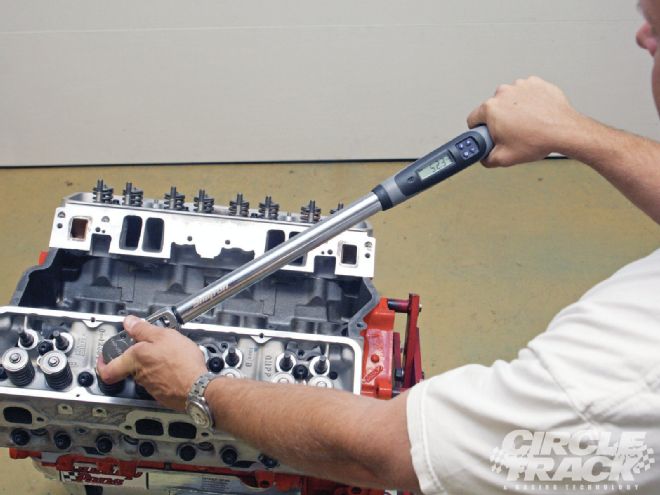
There’s more to the nuts and bolts fastening the most critical components on your race car than simply getting them “tight enough.” Bolts don’t work by simply clamping down on something thanks to the pressure you apply twisting the nut. The steel can actually stretch a few thousandths of an inch. It’s the elasticity of the steel trying to pull itself back to its original length that allows a bolt to provide a consistent clamping load. Plus, this constant pulling force that remains long after the wrench has been removed helps keep the nut from coming loose under the vibrations that come from racing.
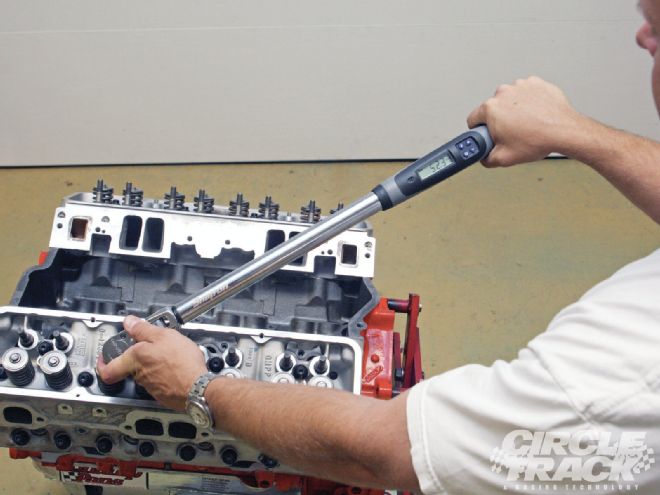 A good torque wrench is critical to properly installing many important fasteners in your race engine as well as your chassis. Make sure you’re using yours properly to get the best results.
A good torque wrench is critical to properly installing many important fasteners in your race engine as well as your chassis. Make sure you’re using yours properly to get the best results.
So if you don’t stretch a bolt enough when tightening the fastener, you won’t get that “pulling” or retracting force on the nut. But if you apply too much force, the bolt will fail. The solution to making sure your most critical fasteners are tightened properly is to use a torque wrench.
In its most common form, a torque wrench simply measures the amount of twisting force, or “torque,” that is required to twist a nut or bolt as it’s tightened. It’sn’t a perfect system because changes in friction can change your torque reading, while actual bolt stretch isn’t affected by friction, but measuring torque is usually the only way to measure the amount of force being placed on a bolt or stud.
That’s why a reliable torque wrench is one of the most valuable tools in any mechanic’s toolbox. It does a job that other handtools can’t, and because of that, mechanics and engine builders place a lot of trust in their torque wrench of choice. Maybe that’s why there are so many myths surrounding these wrenches. Everything from how to store them to how they are best used.
For this article we discussed torque wrench technology and the best use practices for these specialized wrenches with Dan Eggert, Hand Tools Engineer with Snap-on Tools, one of the most trusted tool makers in racing, and Chris Raschke with ARP, which manufactures high-end fasteners and has done as much research and development on how torque affects fasteners as any company in the racing industry. We ran several of the most widely held myths past them to get not only their answers, but the reasons why.
It’s a fact of life that stuff gets dropped, knocked off workbenches, and generally treated to many different forms of abuse that they may or may not be able to handle. Knocking your ½-inch box-end wrench off the workbench is no big deal, but a torque wrench is a precision piece of equipment and should be treated as such.
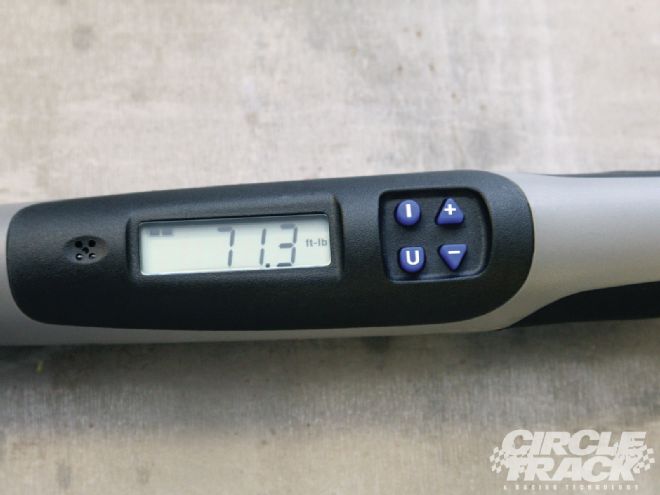 In order to be most accurate, a torque wrench needs a slow, steady pull up to the desired torque. Some bolts, like those securing the main caps, require a lot of torque. Make sure you have the block secured and you’re in a position to apply the final torque in a steady pull without jerking or tugging the wrench.
In order to be most accurate, a torque wrench needs a slow, steady pull up to the desired torque. Some bolts, like those securing the main caps, require a lot of torque. Make sure you have the block secured and you’re in a position to apply the final torque in a steady pull without jerking or tugging the wrench.
One accidental drop to the shop floor probably isn’t a big deal, but repeated drops can affect the wrench’s calibration. This is true even if it doesn’t show signs of damage. The easiest way to check your torque wrench is to check it against another wrench. Torque a bolt with one wrench and then try to torque the same bolt with the second wrench on the same torque setting. If the second wrench pulls the bolt down farther before marking the same amount of torque, you know one is off. Then repeat the same process with the order of the wrenches reversed.
Of course, this isn’t exactly the most scientific method. Even if you have never dropped or otherwise abused your torque wrench, it’s always a good idea to have it professional checked regularly. Professional shops normally have several wrenches and send them in for professional calibration every six months or so. If you use your wrench regularly, you should consider sending it in probably about once a year—or sooner if you suspect yours isn’t working properly.
One of the advantages of purchasing a wrench from a professional tools company like Snap-on is that it has services like this in house. Eggert says Snap-on actually has facilities across the country that can check and recalibrate its torque wrenches. All you have to do is hand your wrench over to the Snap-on truck driver whenever he visits your shop (or you can flag him down) and he’ll take care of it for you. Simple as that.
If you’re using a mechanical click-type wrench, this one turns out to be absolutely true. A click-type torque wrench presses a ball into a detent that’s held in place by a spring. The wrench is normally adjusted by twisting the handle on the wrench. Twisting it in compresses the spring and requires more torque to pop the ball out of the detent. This is how it measures torque.
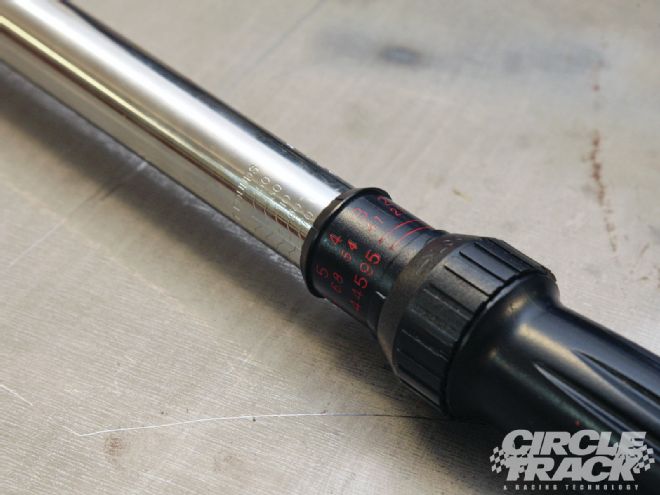 A click-type wrench is popular and dependable. You set the amount of torque you want by twisting the handle of the wrench. This compresses a spring in the handle which increases the amount of torque required before a steel ball will pop out of its detent inside the wrench, giving you the familiar “click” to let you know you’ve reached your desired torque setting.
A click-type wrench is popular and dependable. You set the amount of torque you want by twisting the handle of the wrench. This compresses a spring in the handle which increases the amount of torque required before a steel ball will pop out of its detent inside the wrench, giving you the familiar “click” to let you know you’ve reached your desired torque setting.
But if the spring is stored with the wrench “loaded” or set for a high torque rating, the pressure on the spring can cause it to weaken over time. To protect the wrench it should always be returned to the lowest setting before storing it back into your toolbox. For big wrenches (measuring in ft-lbs increments) the lowest setting is usually 20 ft-lbs. If, for some reason, you have a click-type torque wrench that goes all the way down to zero, leave the wrench set to 10 or 20 pounds. You always want to keep a minimum amount of pressure on the spring so that the ball can’t fall all the way out of the detent.
For other styles of torque wrenches, this isn’t an issue. The newest digital torque wrenches use an electronic strain gauge to measure torque, so when the wrench is not in use the only thing you may need to do is remove the batteries so that there is no chance of corrosion ruining your expensive digital wrench.
This one isn’t true, and in fact, the truth may be quite the opposite depending on conditions. Mechanical wrenches normally depend on either the ball detent mechanism mentioned earlier or a beam that flexes as more torque is applied to the bolt. They are relatively simple mechanisms and dependable.
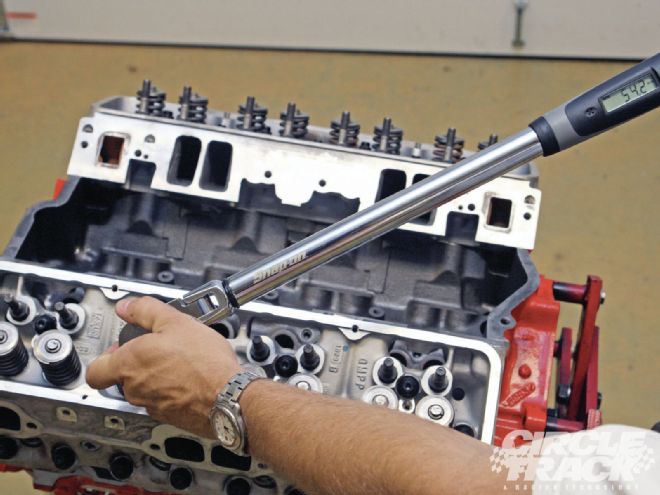 The newest generation of torque wrenches are more accurate than ever before. Most use a strain gauge inside the wrench (sort of like an engine dyno), and wrenches like this one from Snap-on can measure down to one tenth of a ft-lb.
The newest generation of torque wrenches are more accurate than ever before. Most use a strain gauge inside the wrench (sort of like an engine dyno), and wrenches like this one from Snap-on can measure down to one tenth of a ft-lb.
But that doesn’t make them any more accurate than the most modern evolution of digital torque wrenches. Snap-on’s TechAngle line of torque wrenches, for example, are all electronic and incredibly precise. They are capable of reading to a tenth of a pound of force, while most mechanical wrenches only read in one-pound increments. The TechAngle wrenches also ship with a Certificate of Calibration printed specifically for your wrench. For the wrench that we tested, no measurement was off by more than one percent (on a range between 50 and 250 ft-lbs) and most were less than one-half of one percent in variance.
Some mechanical torque wrenches use a beam scale or a dial indicator to indicate the torque. While accurate, these can also lead to user error because of a phenomenon known as “parallax distortion.” That’s a fancy way of saying “you ain’t looking at it straight.”
Parallax distortion happens when the viewer is observing the gauge at an angle. For example, imagine a needle on a round dial gauge pointed directly over the five on a scale of one to 10. Looking at the gauge directly head-on, the needle is obviously pointing at the five, but if you move your head to the side in one direction it may look like it’s over the four (like in the picture to the left), and if you move your head in the other direction far enough the needle will look like it’s instead pointing at the six. This can be a real problem with torque wrenches that use an analog gauge, especially if you’re working in tight confines in your race car and can’t position your head directly over the gauge.
This isn’t an issue with click-type wrenches or those with digital gauges. But some wrenches with a digital readout have another advantage. The Snap-on TechAngle we tested will actually read back the maximum torque setting after the pull so that you can tell exactly how much torque has been applied.
This one is the truth. You might argue that if a torque wrench can handle tightening bolts to 250 ft-lbs, it should be able to reliably handle loosening that same bolt. And this is true, but when it comes to loosening a fastener you don’t always know what’s going to be required to get it loose.
After several heat cycles and the accumulation of dirt and grime that can coat everything in a race car, a bolt can gall against the threads and require a lot more torque to remove than was required to originally install. Most of us don’t watch the torque when loosening bolts, so it’s quite possible to exceed the maximum torque loading of a wrench when breaking bolts loose. The wrench will still function in terms of tightening or loosening bolts, but by exceeding its maximum torque limit loosening that tight bolt may have thrown off the calibration.
Yes and no. Whether you use a standard or deep socket isn’t an issue. Neither are adaptors to fit, for example, a 3⁄8-inch drive socket on ¼-inch drive ratchet or even short extensions. But anything that moves the head, or pivoting point, of the torque wrench away from directly vertical to the fastener being torqued can affect your reading.
This includes wobble extensions, or crow’s feet. Crow’s feet extensions are necessary on some Chevy SB2 heads and other race-only cylinder heads that put a priority on port location and performance over ease of installation. If you find yourself in a situation where you must use some type of horizontal extension on your torque wrench, consult the manufacturer to see if it offers any means of compensating for the change in leverage.
The answer is this statement is incorrect, but it still isn’t a good idea to try to increase the torque on an already tightened bolt by 5 pounds or less.
 One more advantage with the new breed of digital torque wrenches is that some can read back the actual torque after you’ve completed your pull. Here, you can see I’ve overshot my 70 ft-lb mark by 1.3 pounds. Knowing this can help the user adjust his style so that he is able to make a slow consistent pull and stop as soon as he feels the wrench buzz in his hand.
One more advantage with the new breed of digital torque wrenches is that some can read back the actual torque after you’ve completed your pull. Here, you can see I’ve overshot my 70 ft-lb mark by 1.3 pounds. Knowing this can help the user adjust his style so that he is able to make a slow consistent pull and stop as soon as he feels the wrench buzz in his hand.
For example, cylinder head bolts are normally torqued in three stages to help improve a consistent clamping load across the cylinder head. Conventional thinking says that these stages should be 10 to 15 ft-lbs apart. So, if you’re installing heads on a Chevy small-block and the final torque value is 70 ft-lbs, then the bolts should be torqued to 40, then 55, and finally 70 ft-lbs.
Smaller increments can often lead to incorrect readings. For example, it’s almost always a bad idea to take a bolt that has already been tightened to 65 ft-lbs and take it to 70. This is true, and if you find yourself in this situation, you should loosen the bolt and then retighten it to 70 ft-lbs.
Many people think the reason is because a torque wrench isn’t able to measure the 5-pound difference in an already tightened bolt, but this is untrue. The truth is that a bolt that has already been tightened will usually have a breaking point (the amount of pressure that’s required to get it moving again) that’s higher than the amount that it has originally been torqued. So, for a bolt that has already been tightened to 65 ft-lbs, the force required to get it moving again could be 5 ft-lbs or more on top of the original 65.
The lesson here is that although your torque wrench is perfectly capable of reading the difference between 65 and 70 ft-lbs, if you ever need to change the torque on an already tightened bolt by less than 15 ft-lbs, first loosen the bolt so that it’s in a relaxed state and start over.
With these myths now busted you’re ready for years of reliable use from your torque wrench.